
HOME





HOME
|

|

|

|

|
|
P R O F I L E |
||||
|
 CLIFTON HOTWELL SPA PAST AND PRESENT1894: THE CLIFTON SPA PUMP ROOM  
(Temple to St. Vincent or St. Vick and the Hotwell). FAÇADE AND MAIN ENTRANCE. 
Above: The Clifton Spa Pump Room façade, Prince’s Lane, c.1920. Drawing by S. J. Loxton, of 7, St. Augustine’s Parade, Bristol. Note: originally with central entrance portico, commanding magnificent views of the Avon Gorge. There was no secondary forest in front of the building then, and originally there was no wall in front, along Prince’s Lane (see Chapter 32). The last in a series of historically authentic Spa Pump Rooms to graciously adorn the Avon Gorge that traditionally celebrated the ceremonial of Hotwell Spa since 1694, The Clifton Spa Pump Room is 100 feet long, 56 feet wide and nearly 30 feet high, larger than the Long Room in Dowry Square (90 feet x 35 feet) and the Prince Street Assembly Rooms (84 feet x 34 feet). These proportions were deliberately meant to impress, creating a feeling of architectural grandeur and continuity with the traditions of 18th century Long Rooms and Assembly Rooms, which were originally, constructed using bricks and roofing timbers, but here we have a metal-framed Victorian engineered building, whose facade had been dressed in Bathstone. Although its height had been restricted so as not to block people’s view of the Avon Gorge, the span of the room and its celebration of entrance were impressive by any standards. The interior was symmetrical, spacious and ornate, with a flat coffered ceiling constructed out of heavily disguised metal girders, which reflected the temple-like architecture of the public buildings of ancient Rome (see Chapter 28). The stone carvings on the façade follow themes taken from early mythology, where satyrs and nymphs, spirits of the Hotwell, woods and gorge, are mischievous and amorous, sometimes depicted revelling at drinking parties, intoxicated by wine and honey, except that here, they are like a post-Renaissance sculpture or painting, hermaphroditic and child like. The Clifton Spa Pump Room was opened by the Mayoress of Bristol on Wednesday 1st August 1894, when Mr. and Mrs. George Newnes entertained about 200 at luncheon in the New Pump Room, Princes Buildings. THE FACADE. 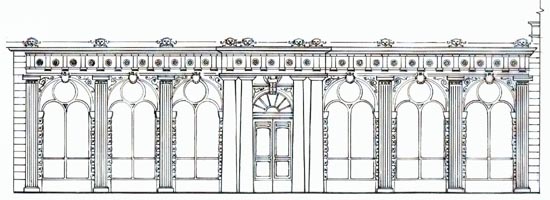
Above: Clifton Spa Pump Room front elevation, facing South West on Prince’s Lane. Drawing by Bruce Tyldesley. The façade itself was in Bathstone ashlar of single story, with three bays, supported by fluted pilasters with Doric capitals on either side of the entrance bay. Each bay had a 2-light, Italianate arched window with a roundel, individually decorated spandrels and scrolled keystones (2-light, meaning that each tall window was divided vertically down the middle by a wooden mullion or post). The individually decorated spandrels included: foliage, man/boy figures on the left, Coiled Dragons (see Chapter 3) on the right, rosettes, flower balls, lion’s heads. Keystones were placed directly above the window roundels, with festoon ornamentation adorning ovolos (oval quarter spheres, often incorporated into the Parisian Beaux-arts style). The classical architectural order of the façade was Doric, which is the earliest order, as opposed to Tuscan, Ionic, or Corinthian, and it might be that Philip Munro was playing with our appreciation of the antiquity of the Hotwell. The frieze on the external entablature was studded at regular intervals with Patera, the classical rosette of antiquity. The cornice of the entablature was emphasised above the pilaster capitals by lion-faced antefixae, in other words, there was a stone carved lion head on top of the roof directly above each column on the façade, which acted to guard the building. There were eight more above each column of the Bathstone portico on the main entrance. The main entrance to the Clifton Spa Pump Room was on Prince’s Lane and the aspect of the façade is South West. Prince’s Lane became the Promenade for the Spa, with its own warm micro climate owing to its aspect and location. Clifton was already renowned for being a mild and sheltered spot. The area in front of the Pump Room was originally a green lawn with a gravel drive. Original plans show an upper gate and lower gate on to Prince’s Lane, to facilitate a carriage sweep to safely deliver visitors to the Pump Room. They would alight in the central entrance portico constructed in Bathstone ashlar (now removed) and situated in the middle of the façade supported by six Bathstone columns and flanked by two caryatids, Giganti or marble maidens, who in turn supported large scroll brackets. Above this, attached to a rusticated frame, with arched-keyed head, the key carried up into a scroll in the pediment. The arched keyed head was placed above the large semi-circular fanlight, over the double-door main entrance. The fan light was adorned either side with two carved stone children, a girl on the left bearing a jug, a boy on the right bearing a wine cup or glass, like a cornucopia of plenty. In the pediment above were two reclining foliaged women, bearing a shield. On this shield, and woven in the masonry, were the initials GN, Sir George Newnes. BACK ELEVATION. The North East aspect was less high because the building was built on a slope, and the roof line kept deliberately low so as not to spoil the view of the Avon Gorge. It consisted of a panelled Bathstone ashlar wall. This was built on top of the retaining wall that held up Sion Hill, which was a separate wall to the interior back wall of the Pump Room. In effect there was a cavity wall. To the left of the back elevation was the Sion Hill entrance to the Pump Room. 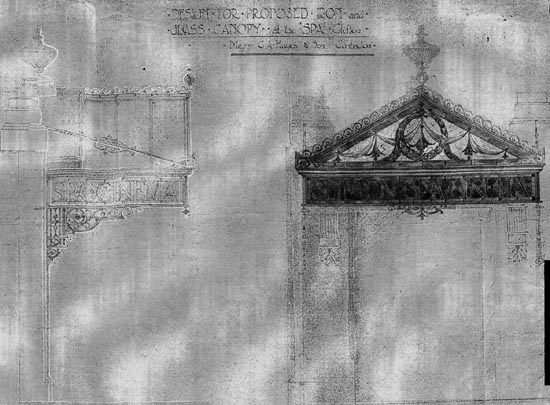
Above: Design for proposed iron and glass canopy. This canopy was designed for the Sion Hill entrance of The Clifton Spa Pump Room, by Messrs C. A. Hayes and Sons Contractor, works and office at St. Thomas Street, Bristol. They were the main engineering contractor for the construction of The Clifton Spa Pump Room and Clifton Rocks Railway, whose name was mentioned in the Catalogue of the Society of Merchant Venturers, along with Sir George Newnes, Sir George Marks and Philip Munro, and repeatedly mentioned in the papers of the day, from the start of the project in 1891, to its completion in 1894. This is the only surviving blueprint (copy of an original drawing) at Bristol Records Office of such a canopy, but it is dated Sept. 1920, labelled under the Improvement Committee of the City of Bristol, and showed lettering that read SPA CINEMA. In 1922 the Clifton Spa Pump Room was converted to a cinema, although the lettering suggests a cinema, it is highly probable that it was the original canopy of the Sion Hill entrance to the Spa Pump Room, which had the lettering added later. In any case, it would have been in keeping with the original style of ironwork that went into the design of the whole building, by C. A. Hayes. There were two carved Bathstone lion heads in foliage that flanked the Sion Hill entrance, with the words written over the entrance, and carved in relief in capitals with serifs, THIS SPRING WAS RENOWNED: THE ORIGINAL PUMP ROOM ERECTED 1694. Directly underneath this was carved the date in much larger script, and in foliage: 1894. The flat roof was not meant to be visible from the front elevation. The flat lead roof, later covered in bitumen, was a key feature in so far as it had three ventilation grills that were of architectural significance for theatrical buildings of that period. Unfortunately these grills were thrown out in 1984, along with much original iron work from the upper portal of the Clifton Rocks Railway, when the hotel first planned to demolish the Pump Room. Ventilation grills were an external reflection of the gasoliers in the ceiling roses of richly decorated interiors before the introduction of electricity, when gas lighting was still being used, which when combined with the natural convection of air produced by the heat of the gasoliers, resulted in an early form of air conditioning. Gasoliers were as huge and ornate as chandeliers, but instead of a candle at the end of each branch there was a gas mantle, which was usually covered by a small, wavy, spun glass lamp shade, like those you would find today in Christopher Wray’s Lighting. Gasoliers were later converted to, or replaced by, electriciers (chandeliers for electric lights), with the introduction of electricity. INTERIOR. 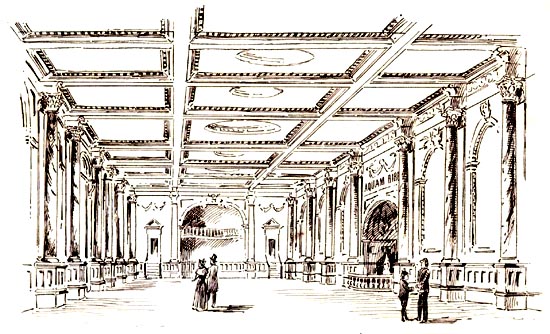
Above: interior of new Pump Room Clifton looking North West. Drawing by S.Loxton, who did many of his drawings in Bristol in the early part of the 20th century, to record how buildings were before they underwent great change. Probably drawn c.1920, even though the general style of dress of the figures seems to imply it is Victorian. Note: Looking North East (right), the Spa fountain was in the middle of the wall. Looking North West (straight ahead), the music gallery was in the middle of the wall. Looking South West (left), the main entrance was in the middle of the wall, flanked by three-bay tall arched windows, through which the sun illuminated the Spa fountain in the apsed centre of the back wall. This is the only drawing of the original interior. Historic Spa Pump Rooms nationwide are famous for their rich interior, colour and ornamentation as well as their classical architecture, and the Clifton Spa Pump Room was no exception. Originally painted in rich golds, reds, blues and yellows, the interior of the Clifton Spa Pump Room was similar to the Great Pump Room in Bath. Walls were decorated with moulded plaster swags linked by rosettes and lion’s heads, also featured on the façade. The classical interior entablature included elaborately moulded cornices, frieze and architrave. The cornice contained, modillions of acanthus leaves in three-dimensional lime-hair plaster, a technique developed during the 18th century for very important buildings, and segmented layers of wooden mouldings, including ovolo (egg and dart) and dentil work. The frieze was a continuous arabesque border of foliage studded at regular intervals with rosettes, like the exterior. The architrave contained one fascia separated by two different, narrowly moulded, formal borders, the upper moulding was wider than the lower and similar in design to the Egypian vase motif taken from antiquity. There were 20 tall monolith columns, 16 in Swiss Cipollino (grey) marble used down the length of the room, and 4 in black granite, 2 at each end. The columns stood forward from the walls and were echoed by 20 slightly-projecting pilasters. A monolith marble column was made from one piece of marble, as opposed to being joined from a number of segments piled on top of one another. Swiss Cipollino marble might have been ordered from a quarry in Saillon (Saillon is a municipality in the district of Martigny, in the canton of Valais), in Switzerland, which might share the same geological seam in the Alps as the better known Greek Cipollino marble. It arrived at the port of Bristol as raw lumps of rock that were turned at Cannon's Marsh. They were shaped with entathis, where the circumference was smaller at the top than the bottom to create the optical illusion that the building was higher than it was, a technique used in ancient temples and public buildings, like the Acropolis in Athens. It also made the columns look more elegant. The moulded plaster Corinthian capitals were studded by rosettes on each of their four sides. During the 18th century, the Corinthian order was applied to Theatres, Banquetting Rooms and other places consecrated to mirth and pleasure (George Richardson, friend of John Carr). The base of the column was turned with scotia (the concave moulding on the base of a column), and finished with oak panelled pedestals. The interior walls were clad in the same dark-stained, wooden panelling up to the same height of the wooden pedestals of the marble columns. This was similar to the wainscots in the Pump Room at James Bolton’s Royal Clifton Spa (see Chapter 23), and also a feature of the interior of the 18th century Prince Street Assembly Rooms (see Chapter 10), which was designed on broad Palladian principles. The original floor was marble mosaic set in design (according to local papers of the day), similar to the entrance foyer of The London Coliseum, designed by Frank Matcham. Today, two slender, black mosaic lines delineate the central floor area in the alcove, where the stone Spa fountain originally stood. This area still contains a mosaic pattern of swirling Palmetto Acanthus: Caulonia, set in black chips, around what was the base of the fountain, against a background of spangled terracotta and gold. The apsed centre was originally coved and balustraded, and semi-circular in plan, projecting out (to create a full circle) into the main floor area of the Spa Pump Room. The colossal weight of a whole floor of marble mosaic set in design, might have been supported underneath by the four rows of brick sleeper walls, which also provided much needed space under the floor to accommodate supply pipes to feed the fountain in the alcove of the Spa Pump Room, and drainage pipes to drain surplus water safely away (sleeper walls and pipes removed by hotel in 2007). The earliest surviving drawing we have of the interior by S. Loxton just shows light and shade, and does not attempt to illustrate any mosaic design to the main floor area. The flat coffered ceiling consisted of 21 sunken square panels, the middle of each panel was studded with ornamental plaster ceiling roses, framed by the decorative cornice, and criss-crossed by decoratively moulded wood-clad girders, spanning the length and breadth of the room, at regular intervals between the Corinthian marble columns. There were three modelled ceiling roses that were larger than the rest, centrally placed and at regular intervals, down the length of the room, from which hung the huge gasoliers, with many swirling, ornamental, silver or gold-metal branches, and small spun-glass lamp shades with glass lustre (many cut glass crystals). The central gasolier was the largest with two smaller ones either side, similar to the chandeliers in the Prince Street Assembly Rooms (see Chapter 10). This alignment, proportion, and colouring, of three ceiling roses and chandeliers, with a strategically placed larger, more elaborate one the middle of the room, was typical of 18th century Assembly Rooms and Spa ball rooms. At John Carr’s 1778 first floor Assembly Rooms (and Great Hotel) appended to the East wing of the Crescent in Buxton, there are three ceiling roses of this configuration, in a finely plastered ceiling by James Henderson, although the original chandeliers were replaced in the 19th century; Carr’s interior also incorporates the locally mined marble, Derbyshire Fossil. At John Forbes’s 1830 Pittville Pump Room there are two-stories, with a centrally placed, finely plastered ceiling dome, from which hangs a huge crystal chandelier. At Francis Greenway’s 1811 Regency Assembly Rooms, on The Mall in Clifton, the centrally placed chandelier might have originally been suspended from the middle of the glass ceiling dome skylight. It is worth pointing out that even if the architect, Philip Munro, had wanted the Clifton Spa Pump Room to be two-storey, or to pierce the centre of the ceiling to create a glass ceiling dome skylight, from which to suspend his largest gasolier, he would not have been allowed to do so, because of the dictates of local residents, who wanted its roofline to be kept flat and low (although the Clifton Spa Pump Room is 30 feet high). The interior wall looking North West. The main feature of the North West wall was the music gallery, which was enshrined by two black polished granite columns either side of it that stood away from the wall. The music gallery was framed by two slightly-projecting pilasters, supporting a moulded, expanded arch, studded with two moulded rosettes. The recess behind this proscenium arch on the North West wall, was the music gallery that formed an arc of a circle in plan upstairs, and an oblong downstairs. Upstairs, there was a projecting balcony with serpentine balustrade, similar to the music gallery in the West wall of the Great Pump Room at Bath Spa. The downstairs floor was raised on a platform from the finished floor level of the Pump Room. Either side of the music gallery was a short flight of steps, each leading to a pedimented doorcase with architectural wooden cornice, similar in design and proportion to the Prince Street Assembly Rooms (see page 29). Each doorcase was framed by two slightly-projecting pilasters, which in turn were positioned exactly behind two columns, one polished granite and one polished marble. Above each doorcase pediment were moulded swags, rosettes and lions’ head. Each door led to a small retiring room with glazed roof lights. The retiring room on the left included a toilet and led out onto Prince’s Lane, the one on the right led through to the upper portal of the Clifton Rocks Railway. 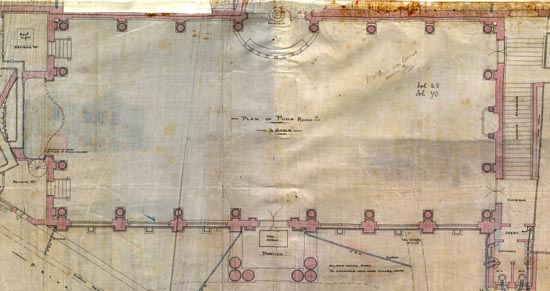
Above: original Plan of Pump Room drawing by Philip Munro, dated 19th Oct. 1892. The main entrance and portico at centre bottom (South West facade). The alcove for the Spa fountain at centre top (interior wall looking North East), Music Gallery on centre left (interior wall looking North West), mantle piece centre right (interior wall looking South East). The interior wall looking North East. 
Above: interior elevation of wall looking North East. Drawing by Bruce Tyldesley. The central feature of the back wall was the apsed centrepiece for the stone fountain of the Hotwell Spa, which comprised a concave, half-dome or semi-circular arch of an alcove. From top to bottom it was decorated with Acanthus leaf marble tracery, now badly salted up, followed by a band of three-dimensional moulded plaster, Palmetto Acanthus: Caulonia, followed by its surround, which was clad in brown, hand-dipped, glazed tiles, with a delicate raised floral pattern, and which created a panel effect. Above the alcove were the words AQUAM BIBE, Latin for “Take the Waters”. Above this were swags, rosettes and a centrally placed, lion’s head. On either side of the alcove was a row of three, arched, shallow niches, each topped by a keystone, in the shape of a classical female face set against a background of fruiting olive branches and leaves, in moulded plaster. Each niche was separated by slightly projecting pilasters at regular intervals, in front of each pilaster were polished marble columns which stood away from the wall. The Prince Street Assembly Rooms also contained six evenly spaced arch-head niches, but they were semi-circular in plan (see page 29). Each niche on the back wall was aligned in size and proportion with each of the six tall, classical, arched, Italianate windows of the building’s façade. The South West aspect of the Spa Pump Room allowed natural light through these windows, which was vitally important for providing the best direct afternoon sunlight illumination of the carved stone fountain, in the central alcove, of the interior wall looking North East, thus creating a natural rhythm to the day (see Chapter 28). The afternoon was the time, traditionally set aside at Spas, when the company would sit, talking scandal, playing cards, and listening to the small orchestra (see Chapter 9). In front of the concave apsed centrepiece was a convex balustrade, of turned Bathstone pillars surmounted by coping stone; this appears on the original plan and in early interior sketches and photographs, and remained there after the Spa Pump Room was converted to a cinema in 1922 and a ballroom in 1928. The interior wall looking South East. 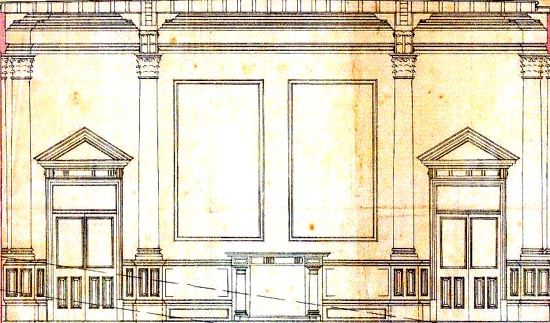
Above: original elevation drawing of interior wall looking South East, by Philip Munro 1893. The central feature of the South East wall was the mantelpiece that might have been made out of the same Swiss Cippolino marble as the columns, with a recess similar to a fireplace in plan. Although it was never a working fireplace, because the original plans show there was no chimney stack built into the wall behind it, the mantelpiece certainly provided a central focal point to this elevation. Something that resembled a large fireplace fender, semi-octagonal in plan, was placed in front of the mantelpiece; this remained there when the Spa Pump Room was converted to cinema in 1922, and a ballroom in 1928. The implication of what appears to be two, plain, oblong panels on the wall above the mantelpiece, as shown in this original drawing (above), seems to compromise the inclusion of something more ornate from an earlier era, such as the carved and gilt frame of the Chinese Rococo-style mirror and clock, which was framed above the wainscot on the West wall of the 18th century Prince Street Assembly Rooms (see Chapter 10). The mantelpiece and oblong panels were framed by two slightly-projecting pilasters supporting a classical entablature, of architrave, frieze and cornice, and enshrined by two black, polished granite columns that stood either side, and away from the wall. Either side of the mantelpiece were two pedimented doorcases with architectural wooden cornices, which were themselves framed by slightly-projecting pilasters and columns, one polished granite and one polished marble, that stood away from the wall. Above each door were moulded swags, rosettes and lions’ heads, not shown in this original drawing above but still present in the building today. The door on the left led to a staircase that linked to the main entrance of the Hydro Hotel that was converted in 1898, the door on the right lead to the marble staircase, which was probably made from the same purchase of Swiss Cippolino marble as the marble columns. The marble staircase swept down behind, and along side, the East wall, from the Sion Hill entrance to the Clifton Spa Pump Room. With its vertical twisted wrought-iron banisters, located with swirl brackets top and bottom, painted gold, and polished dark wooden hand rail. It elegantly spun 450 at the bottom, to meet the pedimented door that entered the Pump Room on the right of the mantelpiece, on the South East wall. Hot-water pipes might have been installed under the floor to heat the room, similar to Victorian churches with ornate metal floor grills, placed round the edge of a marble mosaic floor pattern, to let the warm air rise and heat a vast space. There is no evidence for individual, hand controlled radiators in the original plans. We know that steam from the Turkish Baths next door, opened in 1898, came out through elaborate round metal grills, placed at regular interval in Victorian Gothic, church-like ceramic floor tiles, set in diamond patterns of black and terracotta (still present today). The Clifton Spa Pump Room was designed in conjunction with a much larger concept to convert the end three terraces of Prince’s Buildings into one of the leading hydropathic establishments of its day, which was fitted with steam, gas and electricity. The day the Hydro Hotel opened, on Wednesday 30th March 1898, the Clifton Chronicle and Digest reported: Although the rooms are provided with fireplaces, every room and corridor throughout the establishment is warmed by hot-water radiators, which are under the control of the occupant. The electric light plays an important point, it being installed all over the premises. Therefore it can be surmised that if hot-water pipes had been installed under the Pump Room floor, of marble mosaic set in design, there might have been elaborate metal grills, similar to those found in the baths set within the scheme of the floor pattern, to allow the hot air to rise through the floor. The hot water might have been heated by the same huge furnaces that heated the water for the Turkish baths, the steam rooms of the Victorian Baths, and the hot-water radiators for the Grand Spa and Hydro Establishment, after 1898. The Hydro Hotel kitchens used gas ovens (see Chapter 32). In 1922, the Spa Pump Room was converted to a cinema when the music gallery was converted to a film operator room and the baths were no more, and. In 1928, it was converted to a ballroom. There is evidence to suggest that gold painted radiators were introduced to the Spa Pump Room after 1952, when it was again used as a ballroom, and the floor was replaced by a sprung wooden dance floor. THE PURPOSES OF THE PUMP ROOM. The main purpose of The Clifton Spa Pump Room was to celebrate taking the Hotwell Spa water, in the historically authentic ceremonial fashion that people had done in Spa Pump Rooms, in the Avon Gorge, since 1694. The Clifton Chronicle and Directory reported on Wednesday 1st August 1894: A full description of the Pump Room and its lofty windows overlooking the picturesque gorge of the Avon, its fountain of mineral water pumped up from the famous “Hotwell” beneath the old Colonnade, its alcove with marble tracery and mosaic floor, is not obtainable until today. There were first class orchestra concerts twice a day. These concerts were designed to co-inside with prescriptive treatments for those who had come to take the water, and would occur at regular hours every day, which created a natural rhythm to the place. The Pump Room was also a venue for entertainment, with occasional balls or special concerts, day time receptions, tea dances, and dramatic entertainments, luncheon concerts and evening dinners. This was in keeping with the tradition of the Spa Pump Room at Old Hotwell House (1694-1822) that had been crowded with fashion of the day. The original tree-lined Promenade on Hotwell Road, which in the middle of the 18th century had been known as New Vauxhall Gardens, now moved up to Prince’s Lane. The main entrance of the Clifton Spa Pump Room was on Prince’s Lane, which had always been a public footpath that linked the original Promenade on Hotwell Road with Sion Hill in Clifton. It had views over to Dundry Hill, Leigh Woods, Nightingale Valley, the Suspension Bridge and the Avon Gorge, and new pleasure grounds were created that reached from Sion Hill to the Colonnade on Hotwell Road, laid out in ornamental gardens, with tennis courts, conservatories, vinery, a tea house overhanging the river, alcoves and terraced walks. The Spa Gardens were intended for use by visitors and residents, who might have been under treatment. Tuffleigh House was a late-Victorian mansion house on Prince’s Lane, opposite the Spa Pump Room, but below it on account of the steep gradient of the Avon Gorge. It was completely renovated and used by Colonial visitors, who didn’t take rooms at the hotel but rather stayed in apartments with their own servants and maids, and who could walk across Prince’s Lane to gain immediate entrance into the Spa Pump Room and baths, without having to go through the hotel. Website: Click Here ADDITIONAL INFORMATION Click website above to return to the chapter index. |
||||
|